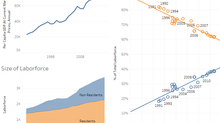Why the Age of AI and Automation Hasn't Fully Arrived—And How to Pave the Way

For years, AI and automation have been heralded as transformative forces poised to redefine the workplace, displacing human workers with machines capable of efficiency, accuracy, and scale. Yet, despite impressive advancements, AI hasn't taken over the workforce in the way many anticipated. While there are notable success stories, most implementations have resulted in incremental improvements rather than seismic shifts. Why is that the case? And what can we learn from these limitations to shape a better path forward?
Let’s unpack this puzzle.
The Four Barriers to Full Automation
1. Customization vs. Standardization
Automation, including AI-driven automation, thrives in environments where tasks are predictable and standardized. For a machine to reliably perform a task, it needs clear, specific, and unambiguous instructions—a level of precision often unattainable in complex, human-centered roles.
Consider jobs in industries like healthcare, consulting, or creative design. These roles require customization to cater to individual client needs or draw upon the worker's creativity and intuition. AI struggles to navigate these contexts because we lack frameworks to clearly define the nuanced inputs that drive successful outcomes.
In essence, the messy complexity of many jobs resists the tidy standardization that automation demands. Until we solve this, humans will remain indispensable.
2. Overpromising and Underdelivering: The Pitfall of Off-the-Shelf AI Tools
Many organizations have turned to off-the-shelf AI tools, lured by promises of out-of-the-box solutions to their challenges. While these tools can offer quick wins, they often fail to live up to the hype.
These tools are typically designed for generic use cases and may not align with the specific needs or complexities of a given organization. As a result, businesses find themselves expending additional resources to tailor these solutions—if they can be tailored at all.
Moreover, off-the-shelf AI tools often oversimplify the challenges of automation, leading to frustrations when they encounter unexpected data, edge cases, or context-specific nuances. The mismatch between the promises of AI vendors and the reality of implementation has left many organizations skeptical and cautious about further investments.
3. Cost vs. Benefit Misalignment
AI is not cheap. Developing, training, and maintaining an AI system—especially for highly specific tasks—requires significant upfront investment in time, money, and expertise. For large organizations with economies of scale, the cost might be justifiable.
However, small and medium enterprises (SMEs)—the backbone of most economies—often cannot absorb these costs. The return on investment (ROI) doesn't always justify the outlay, leading many to abandon automation efforts halfway through.
Moreover, the hype surrounding AI has led to inflated expectations. When AI fails to deliver immediate, transformative results, it breeds disillusionment. The cost-benefit misalignment thus becomes a significant barrier to adoption.
4. The Overlooked Art of Job Redesign
AI can automate tasks, but jobs are rarely made up of a single, isolated task. They are a tapestry of responsibilities, some repetitive, others requiring judgment, empathy, or creativity.
Successful adoption of AI requires mindful job redesign. What tasks can and should be automated? How will those changes alter the worker’s role? What new skills will they need? These are critical questions that are often overlooked in the rush to implement technology.
Without thoughtful redesign, automation risks creating fragmented workflows, alienating employees, and failing to deliver the intended benefits.
How to Bridge the Gap
If we are to unlock the transformative potential of AI and automation, we need a deliberate approach. Here’s what that might look like:
1. Focus on Task-Specific Automation
Rather than automating entire roles, organizations should focus on identifying repetitive, low-value tasks within jobs that can be streamlined. This approach aligns with AI’s current strengths and allows workers to shift their energy toward higher-value, human-centric activities.
2. Invest in Standardization
Where possible, invest in creating standard operating procedures (SOPs) and frameworks that clearly define inputs, processes, and desired outcomes. This is not just about enabling automation; it also improves consistency and efficiency across human and machine workflows.
3. Prepare for Organizational Change
Automation is not a plug-and-play solution. Organizations must invest in training their workforce to work alongside AI, manage the transition thoughtfully, and address resistance to change.
Job redesign needs to be a strategic effort. Define what workers will do post-automation, align incentives to new responsibilities, and provide resources to upskill employees.
4. Set Realistic Expectations
AI is not magic. Organizations must understand its limitations, whether it’s handling exceptions, contextual decision-making, or ethical considerations. Success requires patience, iteration, and a willingness to accept that transformation takes time.
The Opportunity Ahead
AI and automation have not failed; rather, they’ve exposed the complexity of human work and the intricacies of organizational systems. While the promises of complete automation may remain distant, there’s immense value in taking incremental steps.
Organizations that succeed will be those that adopt a pragmatic approach: automating with precision, redesigning jobs with intention, and preparing their people to thrive in the age of intelligent systems.
It’s not about replacing humans; it’s about enhancing what humans can do. The future of work will be human-AI collaboration, not competition—and that future is ours to design.
What do you think? Are we moving too slowly—or have we misunderstood the nature of automation altogether? Let’s continue the conversation.

























Comments